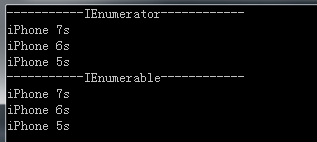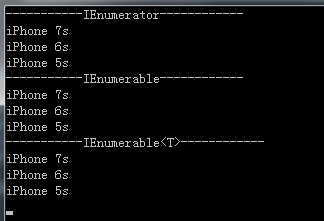C# IEnumerable 和 IEnumerator接口浅析
温故而知新,可以为师矣,有空经常复习一下基础知识是有必要的,并且能加深理解和记忆。
Foreach常用于循环访问集合,对实现IEnumerable的接口的容器进行遍历,IEnumerable和IEnumerator接口我有时候也有点迷糊,按官方的解释,IEnumerable是枚举器接口,IEnumerator是迭代器接口,从字面意思来看相差不大,逐一分析一下。
IEnumerable接口
public interface IEnumerable { IEnumerator GetEnumerator(); }
继承IEnumerable接口的类需实现暴露出来的GetEnumerator()方法,并返回一个IEnumerator接口对象,看来真正做事的是IEnumerator,F12看一下IEnumerator又有什么鬼东西。
IEnumerator接口
public interface IEnumerator { object Current { get; } bool MoveNext(); void Reset(); }
IEnumerator接口有三个东东,一个属性Current,返回当前集合中的元素,方法MoveNext()移动到下一个,遍历不都是向后遍历的嘛,Reset(),字面意思重置,这个容易理解。做个假设:既然IEnumerable接口返回是IEnumerator接口迭代器来实现的,那么仅继承IEnumerator迭代器接口能不能实现一个自定义容器?
定义一个Phone类
public class Phone { public string Name; public Phone(string name) { this.Name = name; } }
定义一个名为MyEnumerator迭代器,并现实它接口IEnumerator
public class MyEnumerator : IEnumerator { Phone[] p; int idx = -1; public MyEnumerator(Phone[] t) { p = t; } public object Current { get { if (idx == -1) return new IndexOutOfRangeException(); return p[idx]; } } public bool MoveNext() { idx++; return p.Length > idx; } public void Reset() { idx = -1; } }
class Program { static void Main(string[] args) {
show("-----------IEnumerator------------"); Phone[] phones = new Phone[] { new Phone("iPhone 7s"), new Phone("iPhone 6s"), new Phone("iPhone 5s") }; MyEnumerator enumerator = new MyEnumerator(phones); while (enumerator.MoveNext()) { Phone p = enumerator.Current as Phone; show(p.Name); } Console.ReadKey(); } static void show(string i) { Console.WriteLine(i); } }
结果显示:

果然不出所料,真正做事情的是IEnumerator接口,即可循环访问自定义的一个容器,不过,初衷是想用Foreach来做循环访问、遍历的。那好,那就只能显示IEnumerable接口来做。稍稍改造一下Phone类:
public class Phone : IEnumerable { public string Name ; public Phone(string name) { this.Name = name; } Phone[] p; public Phone(Phone[] t) { p = t; } public IEnumerator GetEnumerator() { return new MyEnumerator(p); } }
static void Main(string[] args) { show("-----------IEnumerator------------"); Phone[] phones = new Phone[] { new Phone("iPhone 7s"), new Phone("iPhone 6s"), new Phone("iPhone 5s") }; MyEnumerator enumerator = new MyEnumerator(phones); while (enumerator.MoveNext()) { Phone p = enumerator.Current as Phone; show(p.Name); } show("-----------IEnumerable------------"); Phone phoneList = new Phone(phones); foreach (Phone p in phoneList) { show(p.Name); } Console.ReadKey(); }
结果显示:

大功告成,再扩展成通用的容器PhonePackage,继承泛型IEnumerable<T>接口即可。
public class PhonePackage<T> : IEnumerable<T> { private List<T> dataList = null; public void Add(T t) { if (dataList == null) dataList = new List<T>(); dataList.Add(t); } public IEnumerator<T> GetEnumerator() { foreach (T t in dataList) { yield return t; } } IEnumerator IEnumerable.GetEnumerator() { foreach (T t in dataList) { yield return t; } } }
static void Main(string[] args) { show("-----------IEnumerator------------"); Phone[] phones = new Phone[] { new Phone("iPhone 7s"), new Phone("iPhone 6s"), new Phone("iPhone 5s") }; MyEnumerator enumerator = new MyEnumerator(phones); while (enumerator.MoveNext()) { Phone p = enumerator.Current as Phone; show(p.Name); } show("-----------IEnumerable------------"); Phone phoneList = new Phone(phones); foreach (Phone p in phoneList) { show(p.Name); } show("-----------IEnumerable<T>------------"); PhonePackage<Phone> phonePackage = new PhonePackage<Phone>(); phonePackage.Add(new Phone("iPhone 7s")); phonePackage.Add(new Phone("iPhone 6s")); phonePackage.Add(new Phone("iPhone 5s")); foreach (Phone p in phonePackage) { show(p.Name); } Console.ReadKey(); } static void show(string i) { Console.WriteLine(i); }
结果显示:

IEnumerator迭代器接口挺啰嗦的,yield是简化了遍历的语法糖而已。
参考List<T>源码:http://www.projky.com/dotnet/4.5.1/System/Collections/Generic/List.cs.html
作者:EminemJK(山治先生)
出处:https://www.cnblogs.com/EminemJK/
您的支持是对博主最大的鼓励👍,感谢您的认真阅读。
本文版权归作者所有,欢迎转载,但未经作者同意必须保留此段声明,且在文章页面明显位置给出原文连接,否则保留追究法律责任的权利。



 浙公网安备 33010602011771号
浙公网安备 33010602011771号